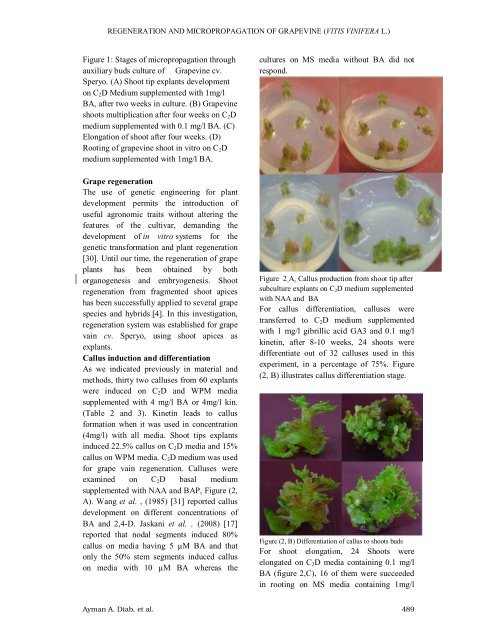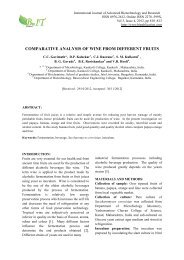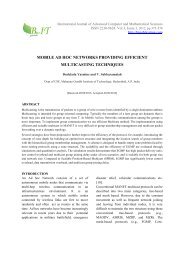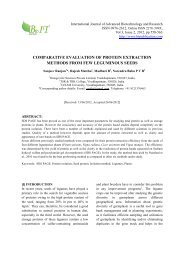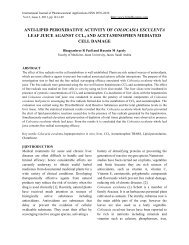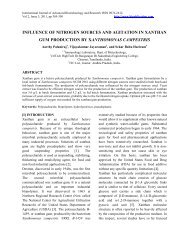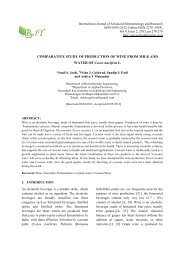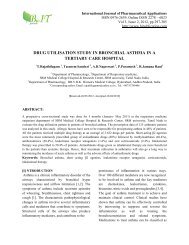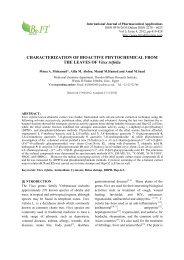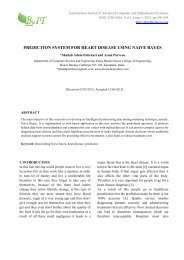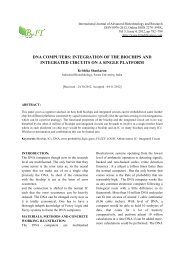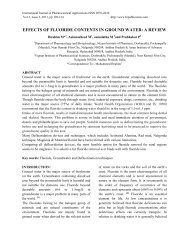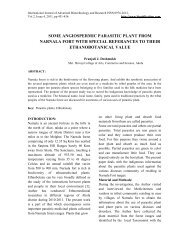regeneration and micropropagation of grapevine - BioIT ...
regeneration and micropropagation of grapevine - BioIT ...
regeneration and micropropagation of grapevine - BioIT ...
Create successful ePaper yourself
Turn your PDF publications into a flip-book with our unique Google optimized e-Paper software.
REGENERATION AND MICROPROPAGATION OF GRAPEVINE (VITIS VINIFERA L.)<br />
Figure 1: Stages <strong>of</strong> <strong>micropropagation</strong> through<br />
auxiliary buds culture <strong>of</strong> Grapevine cv.<br />
Speryo. (A) Shoot tip explants development<br />
on C 2 D Medium supplemented with 1mg/l<br />
BA, after two weeks in culture. (B) Grapevine<br />
shoots multiplication after four weeks on C 2 D<br />
medium supplemented with 0.1 mg/l BA. (C)<br />
Elongation <strong>of</strong> shoot after four weeks. (D)<br />
Rooting <strong>of</strong> <strong>grapevine</strong> shoot in vitro on C 2 D<br />
medium supplemented with 1mg/l BA.<br />
Grape <strong>regeneration</strong><br />
The use <strong>of</strong> genetic engineering for plant<br />
development permits the introduction <strong>of</strong><br />
useful agronomic traits without altering the<br />
features <strong>of</strong> the cultivar, dem<strong>and</strong>ing the<br />
development <strong>of</strong> in vitro systems for the<br />
genetic transformation <strong>and</strong> plant <strong>regeneration</strong><br />
[30]. Until our time, the <strong>regeneration</strong> <strong>of</strong> grape<br />
plants has been obtained by both<br />
organogenesis <strong>and</strong> embryogenesis. Shoot<br />
<strong>regeneration</strong> from fragmented shoot apices<br />
has been successfully applied to several grape<br />
species <strong>and</strong> hybrids [4]. In this investigation,<br />
<strong>regeneration</strong> system was established for grape<br />
vain cv. Speryo, using shoot apices as<br />
explants.<br />
Callus induction <strong>and</strong> differentiation<br />
As we indicated previously in material <strong>and</strong><br />
methods, thirty two calluses from 60 explants<br />
were induced on C 2 D <strong>and</strong> WPM media<br />
supplemented with 4 mg/l BA or 4mg/l kin.<br />
(Table 2 <strong>and</strong> 3). Kinetin leads to callus<br />
formation when it was used in concentration<br />
(4mg/l) with all media. Shoot tips explants<br />
induced 22.5% callus on C 2 D media <strong>and</strong> 15%<br />
callus on WPM media. C 2 D medium was used<br />
for grape vain <strong>regeneration</strong>. Calluses were<br />
examined on C 2 D basal medium<br />
supplemented with NAA <strong>and</strong> BAP, Figure (2,<br />
A). Wang et al. , (1985) [31] reported callus<br />
development on different concentrations <strong>of</strong><br />
BA <strong>and</strong> 2,4-D. Jaskani et al. , (2008) [17]<br />
reported that nodal segments induced 80%<br />
callus on media having 5 µM BA <strong>and</strong> that<br />
only the 50% stem segments induced callus<br />
on media with 10 µM BA whereas the<br />
cultures on MS media without BA did not<br />
respond.<br />
Figure 2 A. Callus production from shoot tip after<br />
subculture explants on C 2 D medium supplemented<br />
with NAA <strong>and</strong> BA<br />
For callus differentiation, calluses were<br />
transferred to C 2 D medium supplemented<br />
with 1 mg/l gibrillic acid GA3 <strong>and</strong> 0.1 mg/l<br />
kinetin, after 8-10 weeks, 24 shoots were<br />
differentiate out <strong>of</strong> 32 calluses used in this<br />
experiment, in a percentage <strong>of</strong> 75%. Figure<br />
(2, B) illustrates callus differentiation stage.<br />
Figure (2, B) Differentiation <strong>of</strong> callus to shoots buds<br />
For shoot elongation, 24 Shoots were<br />
elongated on C 2 D media containing 0.1 mg/l<br />
BA (figure 2,C), 16 <strong>of</strong> them were succeeded<br />
in rooting on MS media containing 1mg/l<br />
Ayman A. Diab, et al.<br />
489


